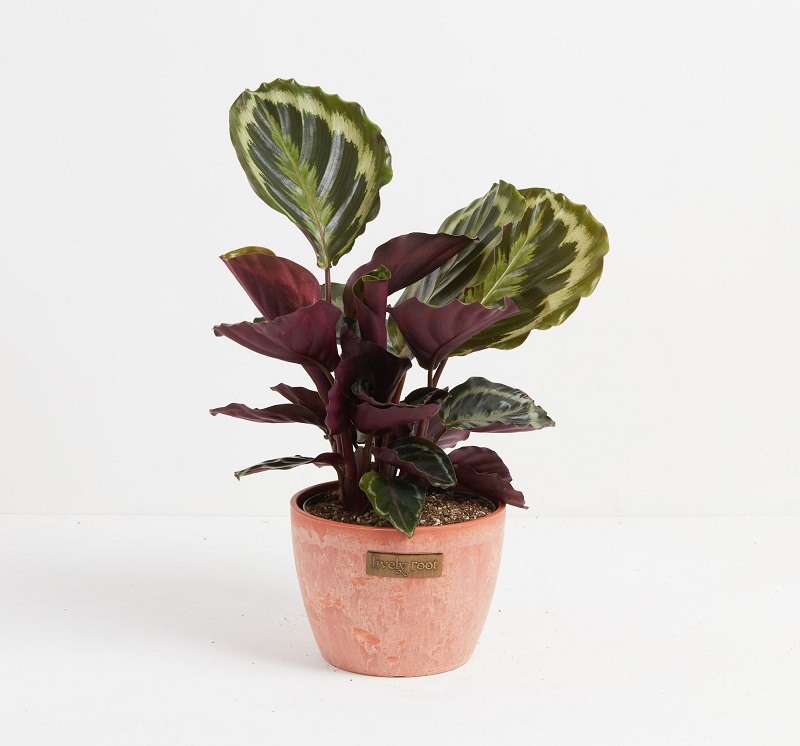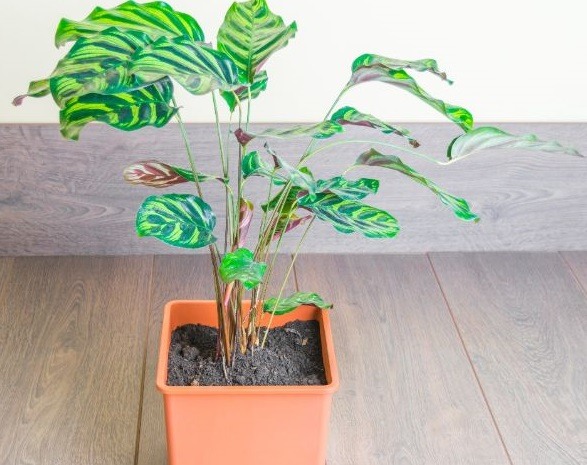I’ve been into houseplant gardening for a decade now. Calathea makoyana has been my favorite indoor plant due to the ease of growth and maintenance. But the success of growing the peacock plant was through costly trials and errors.
Peacock plant care involves the provision of bright indirect sunlight, a temperature range of 60-75oF (16-24oC), well-draining soil, and high humidity. Apply a dilute balanced fertilizer every 2-4 weeks during spring and summer.
Taking care of the peacock plant and creating conditions in which it will flourish is a no-brainer task. Continue reading this guide to learn how to grow and care for calathea makoyana regardless of your experience.
You May Also Enjoy: How to Care for Oyster Plant

What Does Peacock Plant Looks Like?
The Peacock plant is also called calathea makoyana. The foliage coloration and shape are similar to the peacock bird. The attractive leaves are the reason behind its popularity in the United States.
Calathea makoyana has a watermelon leaf-like pattern with contrasting maroon-purple color on the underside. The leaves relax during the day and rise to reach the light at night.
This evergreen perennial hails from the tropical forest of South America. The tropical origin allows the peacock plant to thrive indoors.
The houseplant can reach two feet tall, and pale-green leaves grow 10 to 12 inches long. The foliages have a dark green feathered effect from the center to the edges.
New leaves look pink before they unroll with pinkish-maroon undersides. These vibrant leaf colorations make a lasting impression in any indoor space.
Peacock plants are safe for humans, cats, and dogs. This houseplant is an excellent option for people with sneaky cats or chew-happy puppies.
Peacock Plant Care Details
| Origin | South America (Eastern Brazil) |
| Botanical Name | Calathea makoyana |
| Common Names | Peacock plant Cathedral Windows |
| Maximum Growth (Approx.) | 2ft tall |
| Light Requirements | Bright indirect sunlight. Avoid direct sunlight. |
| Watering Needs | Maintain consistent soil moisture. Soak the soil once the 2-3 inches of topsoil is dry. |
| Soil Requirements | Fertile and well-draining potting mix. |
| Temperature Range | 60-75oF (16-24oC) |
| Fertilizer Application | Feed the plant every 2-4 weeks with liquid fertilizer. |
| Humidity Needs | Above 60% to keep the plant happy and healthy. |
| Pruning and Maintenance | Remove old or damaged leaves. Pinch back to enhance compact growth. |
| Propagation | Division during spring and summer. |
| Re-potting | Every 1-2 years at the start of the growing season. |
| Pests and Diseases | Pests: Aphids, Spider Mites, and scales Diseases: Root rot and Leaf spot |
| Toxicity | Non-toxic to pets and humans |
How to Care for Calathea Makoyana
Choose Soil for Calathea Makoyana
Calathea makoyana thrives in fertile and well-draining potting soil. The potting media should also hold a fair amount of moisture and provide better root aeration.
All-purpose potting soil is the best formula to consider for your houseplant. It can hold a fair moisture amount, drain quickly excess water, and provide aeration around the roots.
Most commercial soil mixes have peat moss, coco coir, pine bark, and perlite. Avoid direct use of coconut coir or sphagnum peat moss due to their ability to hold excess water.
The addition of sand or perlite in the potting soil helps to improve drainage. Peat moss holds a fair amount of moisture and also boosts soil fertility.
Be sure to use a pot with drainage holes at the bottom. These holes will also help to get rid of excess water and prevent potting soil from getting soggy.
Peacock Plant Watering Needs
An appropriate watering routine is the main peacock plant care tip. It helps to keep the houseplant hydrated and healthy for an extended period.
Inspect the potting soil moisture content before watering your favorite plant. Insert the index finger in about 2-3 inches of topsoil and soak with water when it is dry.
Soak the potting soil with distilled water or rainwater until the excess water runs through the drainage holes. Ensure the potting medium does not get soggy in the long run.
Reduce the watering frequency in winter due to the dormancy phase. Peacock plant leaves turning yellow are due to overwatering. Under-watering causes brown peacock plant leaves.
Tap water contains fluoride and chlorine minerals that damage the foliages. Allow the tap water to stay overnight in a bucket before watering your houseplant.
Does Peacock Plant Need Sunlight?
Peacock plants are native to the Brazilian rainforest. These tropical plants thrive under the canopy by receiving limited direct sunlight.
The native environment makes these plants have lower light requirements than other tropical houseplants. Every houseplant enthusiasts need to replicate the growing conditions at home.
Place the peacock plant where it receives bright indirect sunlight. I recommend a north-facing windowsill or east-facing window to the good light level provision.
Ensure the windows have curtains that shield the plants from direct sunlight. Excessive exposure to direct sunlight might damage the leaves or ruin the plant’s appearance.
Low-light conditions might cause discoloration, slow growth rate, and smaller leaves formation. I recommend the use of artificial lights in such scenarios.
Calathea Makoyana Humidity Requirements
Peacock plants do best in homes with higher humidity levels. The high humidity of about 60% and above makes the houseplant healthy.
I recommend placing the houseplant in the bathroom with adequate natural light. The warm moist air is reminiscent of its tropical origin.
Brown leaf tips and edges are due to low indoor humidity levels. It would be best to adjust the indoor humidity to avoid the peacock plant brown leaf tips and edges.
Use a digital hygrometer to detect the humidity changes. I usually group the houseplant to help in increasing the humidity level.
Another excellent option is to install an electric humidifier. It will help to increase air moisture around the plant and promote better growth.
Peacock Plant Temperature Needs
The temperature requirement for peacock plants is the same as for humans. Calathea makoyana thrives under a temperature range of 60-75oF (16-24oC).
Sudden temperature changes may cause drooping and other serious cases. Keep your favorite houseplant away from cold and hot drafts.
The low temperature might trigger dormancy and a slow growth rate. I use a digital thermometer to adjust my indoor temperatures.
Peacock Plant Fertilizer Requirements
Feed peacock plant every 2-3 weeks with a dilute fertilizer during spring and summer. Do not apply fertilizer during winter due to the slow growth rate.
Calathea makoyana are sensitive to over-fertilization. Too much fertilizer will make the peacock plant leaves turn brown.
Use fertilizer rich in nitrogen, potassium, and phosphorus. Another option is to make homemade fertilizer for houseplants.
It would be best to read my article guide about How to Make Homemade Fertilizer for Houseplants. The information will help you avoid issues related to over-fertilization.
Pruning and Maintenance
Calathea makoyana needs minimal pruning requirements when compared to other calathea varieties. Trim the old or damaged leaves with a pair of sharp and sterilized scissors.
Trimming helps to maintain compact growth and bushy growth habit. I recommend pruning the houseplant during spring and early autumn.
Peacock Plant Propagation
Dividing crown and root ball into sections is the best method for propagating peacock plants. I recommend undertaking the task when re-potting the houseplant during spring.
Re-pot each section to a new container with fresh potting soil. Ensure the indoor condition has a higher humidity level to foster new growths.
Re-potting Peacock Plant
Calathea makoyana is less vulnerable to the root-bound problem due to its slow growth rate. But undertake the task every 1-2 years during springtime or early summer.
Springtime is the best period to re-pot due to the active growth after winter. It enables the houseplant to bounce-back fast after re-potting.
Use a slightly larger container and fresh potting mix when re-potting the peacock plant. Ensure the potting soil enhance root aeration and drain quickly.
Add compost to the potting soil to improve its fertility. Soak the potting medium and provide ultimate peacock plant care for a faster growth rate.
Calathea Makoyana Problems and Solutions
Pests
Inappropriate growing conditions make peacock plants vulnerable to insect infestations. These sap-sucking creatures damage the plant’s vital tissues.
Aphids, spider mites, and scales are the leading pests that attack peacock plants. Use an insecticidal soap spray to eradicate the pests on the houseplant.
Diseases
All calathea varieties are vulnerable to root rot and pseudomonas leaf spot. Root rot is due to overwatering during the winter period.
The soggy soil suffocates the root and encourages fungal growth. The root condition causes leaves to turn yellow, wilt, and mushy soil.
I recommend re-potting the houseplant to revive it. Be sure to trim the affected roots with a sterilized blade and avoid overwatering your houseplant.
Leaf spot causes brown spots on leaves and discoloration in the long run. The bacterial disease occurs when the leaves are wet. Use copper bacteriacide to treat the leaf condition.
Peacock Plant Leaves Curling
Calathea makoyana leaves curling is a sign of dehydration. The plant curls the leaves to reduce the water loss rate. Under-watering and low humidity are the possible causes.
Peacock Plant Leaves Turning Brown
Mineralized water, low humidity, and over-fertilization are the potential cause of peacock plant leave turning brown. Investigate the houseplant to identify the exact cause before fixing it.
Peacock Plant Leaves Turning Yellow
Overwatering is the reason behind the peacock plant leaves turning yellow. Other possible causes are low temperatures and humidity. Investigate the plant to identify the exact cause and fix it.
Frequently Asked Questions
Do Peacock Plants Flower?
Yes. Calathea makoyana produces inconspicuous tiny flowers peeping through the pale green bracts on a mature plant.
Are Peacock Plants Toxic?
No. The Peacock plant is safe for pets and toddlers. But keep your houseplant away from pets and children to avoid destruction.
Do Peacock Plants Close at Night?
Yes. Calathea makoyana closes leaves at night and opens them in the morning. The natural light moves the joints and triggers the opening of leaves.
Are Peacock Plants Same As Prayer Plants?
Not really. Peacock plants do fold leaves at night and open them in the morning like prayer-plants. The closing and opening mechanism make the houseplant similar to prayer-plants.
You May Also Read: How to Grow and Care for Fittonia Plant

Final Thoughts
The peacock plant (calathea makoyana) is a wonderful houseplant. The foliage coloration and bushy appearance bring a tropical feeling to a home.
How to care for a peacock plant involves the provision of bright indirect sunlight, high humidity, well-draining soil, and a temperature of 60-75oF. Feed the plant every 2-4 weeks during spring.
I hope this peacock plant care sheet was helpful. Use the comment section to share your experience and questions regarding calathea makoyana care tips.
